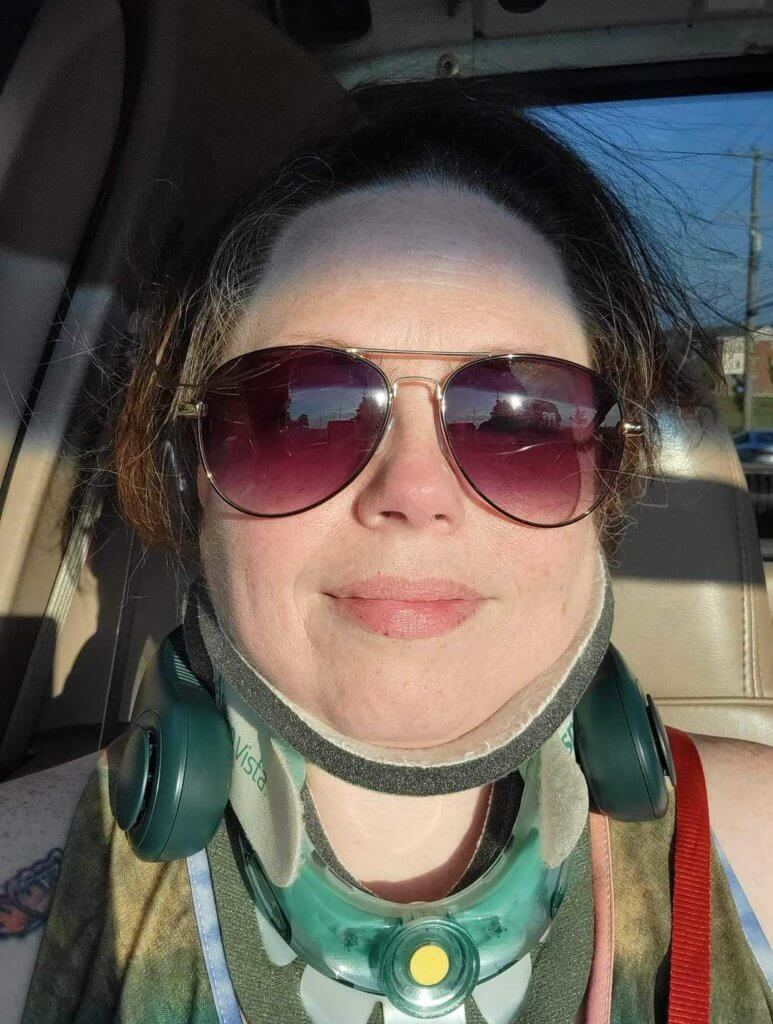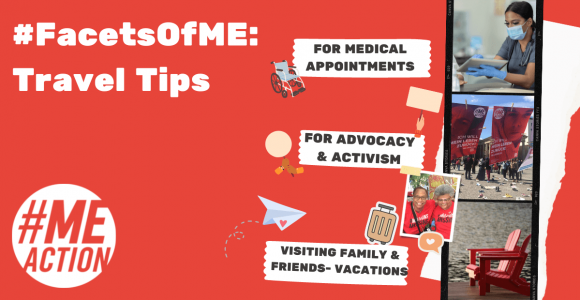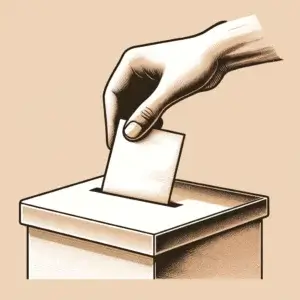Welcome to August’s Facets of ME! If you are unfamiliar, #FacetsOfME is a new #MEAction feature this year where we take time to explore one facet or aspect of myalgic encephalomyelitis (ME/CFS). Sometimes it is a symptom and sometimes it is a unique aspect many of us face living with ME. So far we have explored post-exertional malaise (PEM), cognitive dysfunction, temperature dysregulation, and loneliness. Next we are going to dive into traveling with ME.
When you add living with a complex chronic disease like ME to the challenges of travel, it can result in anywhere from a taxing to extremely difficult experience—if it is even possible at all. We know that many cannot travel and we mourn that loss with you and hope you might be able to again one day. Others only travel for medical appointments and it takes a lot of prep and recovery time. Some of us can visit family and friends occasionally or go on vacation. Some of you might be headed to a protest soon. We want to help make those experiences easier for you. We have gathered tips from our amazing community, scoured the internet for the most helpful advice and links, and hopefully packaged it in an easy-to-cognitively-digest way. Whether travel for you is a couple of hours in a car, a domestic or international flight, or packing up a camper and taking your accommodations with you; we think you will find this #FacetsOfME useful.
At this moment in time, we also have a pandemic to think about. And that certainly should factor into travel planning but there are a lot of resources where you can get that info so we link out to some below but do not go in depth on pandemic preparations.
First, let’s tackle packing health necessities. Packing can no longer be throwing a couple of things in a bag and heading out the door but if we prepare we can better enjoy new sites and seeing loved ones.
PACKING YOUR HEALTH NECESSITIES
Pack a carry-on/car bag/beside the bed bag. This has your must-haves that you cannot risk an airline losing or that you might need to access on a long car trip. Once you arrive, you want to be able to have them within grabbing distance beside your bed. Here is a handy list you can use when packing. Smaller items are listed first for when we need to keep our carry-on small, and larger items are toward the bottom of the list. Some of these will be more useful to you than others. Pick what you most need if space is limited.
- Prescription meds
- OTC meds
- Supplements
- Emergency contact info/Medic alert bracelet
- Sunglasses
- Ear defenders/headphones/foam earbuds
- Sleep mask
- Water bottle
- Packet of electrolytes
- Face mask
- Hand sanitizer or disinfectant hand wipes (be cautious of scents)
- Easy snacks of safe food
- Heat pack or patch such as thermacare. Heating pad with special plug in.
- Ice pack
- Cooling scarf
- Compression items as needed
- Travel pillow
- Travel blanket
- Portable personal fan
- Tissues
- Non-medical travel necessities such as a wallet, passport, money, phone, tablet, charger, feminine hygiene items, or a change of underwear can also be in this bag.
Special considerations: Supplies for your feeding tube, incontinence products, neck brace, etc. Please plan for what you use on a daily basis to be within reach. Check out our links at the bottom for many helpful tips for traveling with disabilities.
Now that you have all of that, don’t forget all the things like clothing, toiletries, and a good book. 🙂
We mentioned packing prescriptions. Let’s go into that more in depth in the next segment.
TRAVELING WITH PRESCRIPTIONS
- Prepare well ahead of time. Go over your current prescriptions and make sure you will be covered for the entire trip including possible delays.
- If you are traveling in the same country, work out what pharmacy you can use at your destination in case of emergency or needed refills.
- In case of international travel see these guidelines from the US State Department site:
- Bring an ample supply of medication to cover you for your trip, and if possible, a few extra days in case there are delays.
- Carry a letter from the attending physician that describes the medical condition and any prescription medications, including the generic name of prescribed drugs.
- Keep medications in their original, labeled containers.
- Check with the foreign embassy of the country you are visiting or transiting to make sure your medications are permitted in that country.
- Keep these packed in your carry-on if you are flying.
- Remember that you should move your prescription medication to an in-room safe or other locked away spot when you are not in your room. Keep them as safe as possible when you are traveling with them. Protective advice you use for keeping your wallet/electronics safe when traveling can be applied to your medications.
Now that we have our prescription packing squared away and have our necessities bag ready, let’s tackle the biggest health necessity we might have for any trip—how will we get around? Let’s focus on mobility aids in the next segment.
MOBILITY AIDS FOR TRAVEL
If you use a certain mobility aid at home, then you most likely need it on vacation. Concerned about transporting it—especially on a flight? Understandable! Check out these articles: Flying With A Wheelchair and Air Travel Tips for Power Wheelchairs, for great tips on traveling with your power chair.
Not taking your chair with you but need help around the airport? Request wheelchair assistance. This might be different depending on the country, so check ahead of time. In the US, airlines are required to promptly provide the requested assistance. Air travelers with disabilities are protected under the Air Carrier Access Act. Check out the Airline Passengers with Disabilities Bill of Rights before you go and be prepared to assert your rights.
If traveling with your mobility aid is not possible, then look into renting one at your destination. Also, please consider renting something at your location if you do not usually need one but will need one to participate more comfortably during travel and vacation. If a wheelchair or scooter will allow you to visit a theme park or go shopping, then rent one if you do not own one. If a cane or rollator allows you more stability, go for it. Search one out to take with you ahead of time or schedule a rental.
Think of what specifically works with your destination. If you are staying with family or friends, is their house wheelchair accessible or would a cane or rollator be more useful? Will you be participating in a protest? A rollator or wheelchair can be especially helpful as those often involve standing and walking. Do you have a way to transport your mobility device? You can rent wheelchairs or scooters that fit in a trunk but you might need assistance lifting them in and out.
Are you going to a beach or somewhere with hiking trails? Look into renting a specialty mobility aid—a beach wheelchair that can go on sand or an all-terrain wheelchair or scooter. These can be a lot harder to find, so book ahead and your best bet might be larger cities.
Now seems like a good time to remind ourselves that just because the mobility aid allows us to do things we could not do without them, it is not a free pass out of PEM. It still takes so much energy to be out and about. We are handling a lot of sensory exposure and cognitive exertion on top of longer times with our feet not elevated. So try to keep your mobility aid plans realistic with a bit of vacation dreaming as well.
Now that you have packed and/or rented what you need, plan out how you keep the batteries charged and obtain any accessories you might need. Pack a way to charge your device. You might want a carabiner clip to add a bag to the back of your wheelchair. A cup holder is very convenient for keeping up with your electrolyte needs.
We hope these segments have been helpful to you. Our next segment is brimming with useful tips that come from lived experience experts—our community! You shared so many wonderful ideas and advice. Thank you for your precious time and energy. A huge goal of Facets Of ME is to give us a place to gather the amazing advice our community shares with one another all the time in support groups and online.
TIPS FROM COMMUNITY
“For any car journey…(as a passenger )even very short ones I always wear sea bands..have a soft pillow behind my head and neck which supports me against those bumps in the road we go over… and a ginger capsule 1/2 hour before I’m due to travel…. and always a bottle of drinking water to take small sips throughout journey. Hope this might help someone.💙”
— Jackie
“Water. Ensure you carry water and/or empty bottles, not just one, for the times that you are in transit and can’t carry water, so that you can fill two bottles at first possibility.
Also carry and use earplugs and eye mask and a sturdy sarong.The sarong is to lie on whenever you need a rest. The other items are self explanatory. Rest and hydration are enormously helpful.”
— Penelope
“Speak up when you need something. I always travel with a folding cane. I am polite, quietly explain that I have a chronic illness, then ask. If for some stupid reason I haven’t requested a wheel chair in an airport, I always approach the gate agent and ask for early boarding because I move slowly and would like to avoid being knocked over. Only once has a gate agent said no. By the same token, I sit in my seat and allow others to disembark first. I take every opportunity to close my eyes, put on headphones, and focus on keeping my breaths long and slow. Always wear sound-cancelling headphones when flying. The noise is exhausting. Always be polite, always express thanks, and before arriving at airport fold bills for tips where I can easily get at them. I always think my gratitude might make things even a tiny bit easier for the next person after me who needs help”
— Barbara
“For any trip outside in the summer months – a neck fan around the collar is a must! Also, cooling towels that come with a pouch to help cool off if getting overheated. If you put it under the fan, it’s like a personal AC!”
— Melinda

“I know this may be controversial but I don’t travel without a small amount of cannabis-infused gummies. For me, they really help manage the physical pain.I also always bring noise cancelling headphones and a good pair of sunglasses for sensory overload.
I try to focus a lot on my mental health because traveling can really exacerbate feelings of isolation and sadness when ME stops you from being able to participate. For me, I do a lot of drawing in a journal to help purge some of the sadness/depression. With my severe hand tremors, it can be frustrating to draw but I’ve worked to be ok with unsteady lines because they’re also an expression of myself.
Finally, I set expectations with my travel partners. I make sure that they 100% understand that if I say “no” that’s my final answer. (Sometimes easier said than done). I also let them know upfront that I will likely need to rest (a lot) but that shouldn’t stop them from having their adventures. Sometimes, I can convince them to text photos so I can still be with them in some capacity.”
— Ohara“I hate labelling myself as ill but my sunflower lanyard can be very helpful. Not everyone knows what it means but last time I was on a plane in 2019 the flight attendant quietly said she had noticed my lanyard and did I need any extra help. I particularly like the cards you can get to help explain your disability if you are unable to. You can get them in different languages which would be useful if you’re able to travel abroad. I’ll put a link to the website. There’s a flag on the top of the page to select which country you’re in. https://hiddendisabilitiesstore.com/shop/sunflower-lanyards”
— Heather
“Car travel: frequent breaks, to get out, even if only a few minutes. Also sea bands, to minimize car sickness. Discovered that audiobooks minimize the internal “are we there yet” dialogue. Air travel: check your airline. I’ve eliminated several who put handicapped on last, or leave you sitting at the gate for hours, with no way to get to the bathroom, etc (I adore Southwest because of their care) pack snacks..carrots and celery are great. Only direct flights,”
— Kris
“Lie down in the backseat on your way to/from appointments.
Use sunglasses in the car, and even in the doctor’s office if the lights are too bright.
Use earplugs or noise cancelling headphones in the car and office. (Assuming you have someone with you to listen for your name to be called.
Ask to use the exam table while you wait in the exam room, and during your appointment.”
— Kris R.
“You can enjoy virtual tours with www.heygo.com. The guide takes you on a tour with his mobile and you can ask questions. It actually feels like traveling! For example I visited Machu Picchu, Pompeï, the gardens of Monet, and saw kangaroo’s in the wild. THere is also a tool to make pictures and a Facebook group to share your picture. I also watched tours with ME friends. All from my own bed”
— Helga
“I rented a scooter from NYC Mobility and they delivered it to my hotel. Used wheelchair service through the airport. Taxi from airport to hotel. My cane/stool filled in the gaps.”
— Desiree
“For me, I need 3-4 days full rest when I reach my destination & a minimum of 2 days full rest before heading back. Sadly, a short break is out of the question.”
— CKJ Artisan
“I invest in an airport lounge pass so I can rest there. And keep with me things like ear plugs and sleep mask. Also, all of the snacks.”
— Dallas
“I’ve been forced to travel between hospitals and nursing homes, and to live out of a suitcase, for years now😢, in the process. My best help (and I’ve had to fight for this, often unsuccessfully) has been to keep everything in my large travel bag, at the foot of my hospital bed (on the bed, at my feet), so that everything is immediately accessible to me, without reaching any further than my own, immediate space at any time.”
— Rare Disease Patient
“I always wear medical grade compression, carry electrolyte packets that mix into water bottles easily to stay hydrated, pack a salty snack, a sweet snack, and a protein snack that I can eat anywhere. Hard candy for dry mouth. Ear plugs for the plane and anywhere it might get too noisy. My darkest, biggest sunglasses. Neck pillow. Cetaphil facial wipes, moisturizer, and my lower leg, portable compression cuffs that have a USB port and cord for charging. They are quiet enough to wear on a plane or use on a long car ride. ALWAYS request wheelchair assistance from gate to gate. Minimize any unnecessary exertion. Always pack ALL meds and supplements in my carry on bag- along with change of underwear, socks, bralette, tank top, and one pair of compression leggings, plus basic toiletries so if my checked bag gets lost- I have essentials and won’t immediately have to stress about where to get what I need. Always pack bandaids and antibiotic ointment, hand sanitizer, and face masks. I travel with an oversized scarf that can double as a throw blanket- and dress in layers to accommodate my rapid body temperature fluctuations. I try to squeeze in 1-2 emergency, 1x use ice packs. If I am checking a bag? Always put a heating pad and 2 x-large reusable ice packs that I can immediately get chilling down in the freezer whenever I arrive at my destination. Always pack my pillow. Always book a place with a full fridge and kitchenette. Pack a few non-perishable meal options, along with a few packets of favorite tea/warm drinks. Check before I go for closest grocery stores that carry perishable items I can eat. Always allow one full rest day after arrival. Carefully pace and keep the schedule flexible.”
— Emily Rose
“The dizziness, the motion, the feeling of not being tethered to ground (that’s best way I can describe what I think flying for feel like). Airplane cabin pressure issues 🥴. I haven’t been on a plane, train, subway, (or really even ridden in a backseat), etc. in years. Terrified of how it might make feel(since I already feel awful being on the ground). Think the only way I could do it is if I took something to completely knock me out from the moment I left home until I reached my destination. At this point I’m just waiting for someone to figure out how I could teleport myself.”
— Michelle
“Book a wheelchair through the airline. Splurge on hotel room with a view, so it’s not as disappointing to sit out some excursions. (And request the bed actually face the view, when possible.)”
— Jill
“My electric wheelchair. Compression Socks. We have a “go bag” in the car with supplies like hydration, medications, electrolyte drinks, pressure cuff, pulse ox, etc. Bulkhead seats on any aircraft to be able to elevate legs, Spreading out tasks. Shower the night before, pack etc.”
— Kristina
“Eyeshades, earplugs, noise cancelling headphones, use wheelchair. If staying somewhere for a few days, try to have a dark sanctuary room available where you can rest during the day.”
— Brian
“I’ve taken to putting the seat right back in the car, & (with my fave pillow) resting this way. With a eye mask plus a good audiobook, I’ve rested better & even managed to snooze. Did this with a 5 hr drive (coz moving house), & it defo helps me rest & keep symptoms manageable.”
— Gwenfars Garden
“I don’t travel anywhere I won’t be received with the needful space & time to recuperate as best I can. Eye mask/ear plugs 4 sleep during travel (unless I’m well enough to actually drive), OTC pain meds, pillows, & my pemf mat. Low key schedule & tons of rest before & after.”
— J. Ruth Kelly
“My son is currently a little less disabled by ME than in previous years and we just had a successful holiday together. It depended upon him keeping his own timings and me enabling/facilitating that. Balancing advanced bookings for peace of mind with flexibility if things went awry.Nobody expected him anywhere until at least 3pm, even if others were out at 10am. Always money for taxis in case of emergency. As I say, he is much less ill at the moment. It would have been unthinkable even a year ago.”
— Dawn
“Fly first class, carry a lot of tip $, and better yet, take a friend or helper with you. Since that’s pretty pricey & Covid & crowds still a concern, I’d stay home. Flippant as that sounds, it’s true. Doubt I’ll ever travel again. I did the above in 2013 & did it alone in 2016 but old friend cared for me while in FL. First Class saves pain & energy & pretty good food. Tip $ keeps a airline worker with you & your airline wheelchair all the way from check-in (best done online) to gate & boarding. Flight attendants can be helpful if they know you’re handicapped, like in flight & first or last to deplane. I bring water & easy hi protein snack food, carry all meds in their bottles, any other needs in tote bag. Carry on luggage if you can. I wear all my jewelry. Take minimum clothing (haha). One can buy nice thrift store extra if needed, esp. in FL. i take iPad, reading too hard now, but some amusement helps. Some airports, like Tampa, have great. Shuttle services portal to portal with that wheelchair attendant helping you wait & get on. Better yet, friend pick up so I can recline/rest/eat in the car. Plan to stay in, maybe in bed, the first day at least. Oh, travel at hours you are most alert. Don’t change planes or stopovers. Same goes for cars. Prepare for all contingencies. Fun, huh? 😃”
— Alice
FINAL THOUGHTS AND LINKS TO FURTHER RESOURCES:
There are so many more aspects of travel that are worthy of discussion—travel insurance, accessible hotels, traveling by train, etc. Thankfully, the wider disability community has been sharing tips, creating sites, and making videos for years. There are also some government resources covering important information on things like the Airline Passengers with Disabilities Bill of Rights and what to expect at TSA screenings. We tried to focus on what we felt was most specific to the ME community in the above and then link out to these great resources to continue our mutual research and learning about traveling with a disability here.
Links and helpful info for travel:
- At this link enter a country or area to find information on accessibility for travelers with mobility limitations in the “Local Laws & Special Circumstances” section.
https://travel.state.gov/content/travel/en/international-travel/International-Travel-Country-Information-Pages.html - European Network for Accessible Tourism
https://www.accessibletourism.org/ - Society for Accessible Travel and Hospitality https://sath.org/
- Considerations for traveling internationally
https://wwwnc.cdc.gov/travel/page/disability - Wheelchair traveling https://wheelchairtraveling.com/
- Tips for traveling with a power wheelchair
https://wheelchairtraveling.com/air-travel-tips-power-wheelchairs/ - Virtual tours recommended by a community member www.heygo.com
- World Health Organization travel advice
https://www.who.int/emergencies/diseases/novel-coronavirus-2019/travel-advice - How to travel safely in a pandemic- Cleveland Clinic
https://health.clevelandclinic.org/how-to-protect-yourself-from-the-coronavirus-while-traveling/ - People’s CDC safer gatherings tips
https://peoplescdc.org/wp-content/uploads/2022/07/Summer-Gatherings-1.pdf - Information for Disabled Travelers: United Kingdom National Rail Service
https://www.nationalrail.co.uk/stations_destinations/passenger-assist.aspx - Amtrak accessible travel service information
https://www.amtrak.com/accessible-travel-services - CDC info on traveling with a disability
https://wwwnc.cdc.gov/travel/page/disability
Links and helpful info for travel in and from the US:
- The US Department of Transportation has developed a series of disability-related training materials to assist passengers traveling with disabilities better understand their rights.
https://www.transportation.gov/individuals/aviation-consumer-protection/traveling-disability - Airline Passengers with Disabilities Bill of Rights published in July of 2022. “This Bill of Rights describes the fundamental rights of air travelers with disabilities under the Air Carrier Access Act and its implementing regulation, 14 Code of Federal Regulations (CFR) Part 382.The Bill of Rights applies to all flights of U.S. airlines, and to flights to or from the United States by foreign airlines.”
https://www.transportation.gov/airconsumer/disabilitybillofrights - TSA screenings for people with disabilities and medical conditions
https://www.tsa.gov/travel/special-procedures - US Department of Transportation Wheelchair and Guided Assistance
https://www.transportation.gov/individuals/aviation-consumer-protection/wheelchair-and-guided-assistance






6 thoughts on “Facets of ME: Travel Tips”
Going from low altitude where I live to even low mountain altitudes causes me to have a full ME/CFS crash — feeling like symptoms of full EBV/HHV reactivation. Anyone have ideas about dealing with changes in atmospheric pressure?
I checked with Jaime Seltzer (our amazing Director of Scientific and Medical Outreach) and she shared these suggestions: “compression stockings, hydration (with electrolytes, if possible), and stuff to address hypoxia, even OTC stuff to quickly brochodilate, like Olbas or menthol-containing rubs” Reminder, of course, to always speak to your medical provider about health concerns. We are not healthcare providers.
Wow. Great info. I may also bring a bag of fresh clean never-used N95 masks, to ask folks near me if they would mind wearing it due me to being immune compromised. I do this at doctors offices w the staff. Most agree. Less folks will when you travel, I’ll bet. But no harm gently asking. Pre-pandemic I always flew w an “I Can Breathe” mask due to my chemical sensitivities. Airline air is awful and often mixed with jet fuel and other people’s perfumes.
Thanks, Rivka! Great suggestions! Flying is hard for so many reasons!
In the US (and maybe elsewhere) hotels provide minifridges for free for medical purposes. All i ever had to say was “need it for medical reasons” (didn’t have to say what or defend) (back when i could travel).
This is a great tip! Thank you!
Comments are closed.